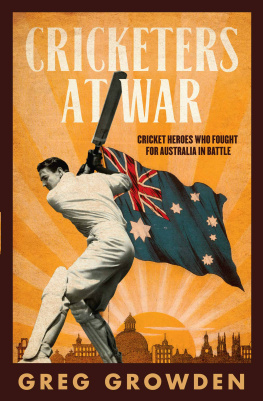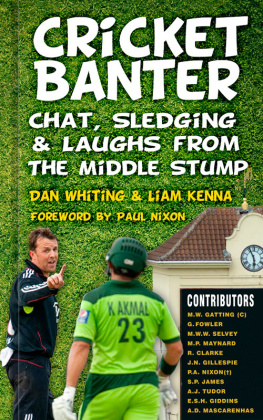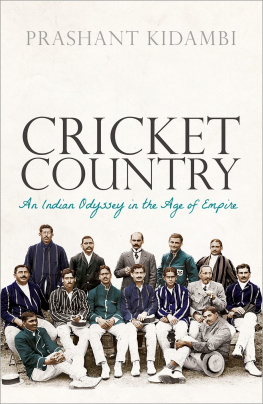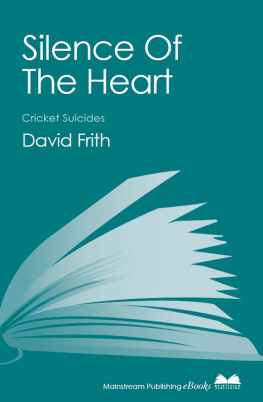

Published by Jaico Publishing House
A-2 Jash Chambers, 7-A Sir Phirozshah Mehta Road
Fort, Mumbai 400 001
www.jaicobooks.com
Makarand Waingankar
GUTS & GLORY
ISBN 978-81-8495-614-6
First Jaico Impression: 2014
No part of this book may be reproduced or utilized in any form or by any means, electronic or mechanical including photocopying, recording or by any information storage and retrieval system, without permission in writing from the publishers.
Page design and layouts: Special Effects, Mumbai
Contents
Foreword
When Makarand Waingankar asked me to write the foreword for his new book, my first reaction was, why me ? He will not divulge his reasons; but I suspect that because Ive played with and against many yesteryear champions, and seen many others at close quarters, he has given me the honour to pen a few words.
Guts & Glory... A book like this should be prescribed by every school, college and cricket association, so modern generations can understand how hard each cricketer has strived to achieve his success. Let me doff my hat to these champions, each one of whom set out to put India on a pedestal and has certainly done so with flair.
Makarand has written about cricketing greats he has watched closely during his long career from a freelance journalist to a hardcore critic. Among these, Pataudi and Jaisimha make a classic pair; they truly enjoyed the game. Tiger Pataudi changed the very face of Indian cricket. I am reminded of my school days when a few of us - Gavaskar, the Amarnath brothers, Solkar and some others who played for India Schools - were led by him in a Moin ud Dowla match at Hyderabad.
Solkar, the bravest of us, asked him, Sir, how do we address you?
He smiled and shot back, Tiger!
Tiger Pataudi was truly the most charismatic captain that India ever had. (One of the most brilliant illustrations in this book depicts Pataudis response to an English writer.) His frequent partner Jaisimha had flair, flamboyance and a shrewd cricketing brain to match. Pataudi, and Wadekar too, benefitted immensely from his experience. Also described in this book, Renaissance man Sardesai inspired a whole generation of young cricketers in the early 70s. Indeed, he has been so vividly described that the author might well have been a part of that dressing room!
Comparisons are odious as they say; Gavaskars technique, Vishwanaths artistry, Vengsarkars courage and Amarnaths comeback are all part of cricket folklore now. Perhaps, Makarand could also have considered writing about one of my favourite players, Chandu Borde, an outstanding captain who scored almost 100 in each innings against the fastest bowling pair of Hall and Gilchrist and the wily Gibbs and Sobers.
To me, the chapters on our five spin greats are both gripping and enchanting. These players literally brought the cricketing world to its feet. Roy Fredricks mention of Prasanna, Bedi and Chandrasekhar sending a shiver down his spine is enthralling. Only fast bowlers ever did that, as I well remember! Imagine the three smiling at you, spinning a web around you and applauding each others success - it was a sight I will never ever forget. Just as the fans erupted when Tendulkar came out to bat, so too, when Chandrasekhar was given the ball by Pataudi, 35,000 Indians rose as one and cheered at Brabourne Stadium! These events are etched in my mind for posterity - Kumble and Harbhajan also revive memories of the spin era.
Many of the stories here are evocative and inspiring. Kapil Dev, one of the greatest cricketers of our time, and his arduous cricketing journey. (Kapil asking for an extra roti to sustain himself makes for a heart-wrenching tale.) Shastri and his progress from a No. 10 batsman to a leading all rounder. And Greg Chappells quotes on Tendulkar, Ganguly, Dravid, Sehwag and Laxman give you an insight into why these men became legends. The saga of the Kolkatta Test is perhaps the greatest win recorded in Test history. Modern cricket history will never find a stronger batting line up than these magnificent five men.
Dhonis rise to fame from a small town speaks volumes of how firmly cricket has seized the country. And Yuvraj Singh s tryst with destiny to become the best player in the 2011 World Cup is the best summation of guts & glory. Of the youngest cricketers in this book - only time will tell how Kohli, Sharma, Dhawan and Jadeja carry forward the destiny of Indian cricket.
Here, let me not forget the outstanding caricatures by Austin Coutinho. Having played club level cricket in Mumbai, he knows the pulse of the cricketer. My favourite caricature is of Gavaskar carrying his bed-roll and telling the umpire, Mind looking after this ? I am staying for the night.
All the hard work and the emotions that have gone in writing this book make it a must-read for the modern day cricketer. Many congratulations to Makarand for reviving the glorious past.
Milind Rege
Former Mumbai Captain
Prologue
Cricket, they say, is a game of glorious uncertainties, but cricket is also a game that, amidst its fanfare, spreads overwhelming joy. In the history of Test cricket, which is over a century long, top players have come and gone, but the game remains the same a backfoot defence has not changed to forward defence and vice versa. As is the human habit, when a few experienced and renowned heads come together at the state or international level, they are tempted to tinker with rules. Arent they supposed to exhibit their cricketing mind?
To an ordinary soul, donning whites, these rules do not affect those with a streak of genius. They deal with the changes without voicing their opinion. They use rules to their advantage; thats what is expected of them. Whether a one-ball theory is good or bad for the game, the God of cricket Sachin Tendulkar will never be heard voicing his opinion about it. Perhaps its below their dignity to read too much into the changes of rules. Their minds are well- trained to tackle such frivolous issues.
However, when they do play the game, what a sight they present to masses! Though India came to be recognized as a world player only after winning the World Cup in 1983 under the captaincy of Kapil Dev, the country produced immense talent and legends before that and has continued to do so ever since.
Try batting a tennis ball with one eye shut and imagine playing the fastest set of bowlers without any protective gear; imagine them hurling the ball with no restrictions on rules, aiming at your head. You will realize that batting out there in the middle, is a different ball game.
Tiger Pataudi did that amazingly with his two-eyed stance, which technically created more loopholes for the bowlers to exploit. Yet he played some breathtaking knocks, toying with bowlers, using his majestic drives. To him, a personal bat made for comfort didnt matter; he could do with any. As Ian Chappell said of Pataudi, every time he came to the crease after an interval, he had a different bat. Many batsmen worry about the design of a bat; they need that to complement their efforts. Why would a genius need help from such a tool?
Then there was this short gentleman, Sunil Gavaskar. At 12, when kids are least bothered about the techniques of the game, Gavaskar was leaving the ball outside the offstump even in gully cricket, frustrating everyone. To all his mates, a game of cricket was fun and they were squeezing in time between school hours and homework. To Gavaskar, however, the batting crease meant everything. Once he got in that area, there was nothing else in the world that he could think of.
Next page











